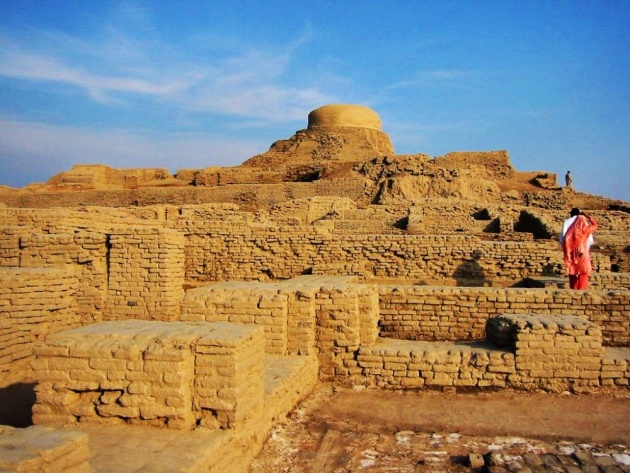
The trip to Mohenjo-Daro is assuredly arduous, but it is nonetheless worthwhile. Rising tall above the mist enveloped and fertile plains of rural Sindh, Mohenjo-Daro is a breathtaking spectacle, a reminder of the historical might and significance of our country.
Startling a person at first sight by its immense splendor, Mohenjo-Daro compels us to imagine for a moment the sheer intellect the ancient dwellers of this city had for their times. If the ruins are this majestic, one imagines, how magnificent would the city have been at its zenith?
Striking Grandeur and Magnificence:
Mohenjo-Daro, once a symbol of the wealth and grandeur of the Indus Valley civilization, is slowly reducing to dust, and if it stands unattended for another few years, we might lose one of the most treasured assets of our nation’s historical legacy.
Mohenjo-Daro was constructed around 2600 BC and many experts believe that a considerable portion of it is still buried, about 65-70% of it. Mohenjo-Daro was discovered in 1922, much to the astonishment of European scientists who had downplayed the theory of ancient civilizations originating in South Asia for a long time.
Yesterday’s Best Preserved Ancient Settlement:
It was, at least when discovered, considered the best-preserved ancient settlement in the Indian Subcontinent. This 5000-year-old city stands as a testament to the great Indus Valley Civilization. The Civilization flourished on both sides of the Indus River across the vast Indus river plateau and beyond it.
At its peak, hundreds of cities flourished in the Indus Plateau, crammed with complex structures such as dams and aqueducts, inhabited by up to 40000 people. It is nothing less than thrilling to walk through 5000-year-old rooms that are still surprisingly discernible.
One is amazed to walk through the splendid wide streets lined with precisely cut bricks baked thousands of years ago yet still astonishingly sturdy. A rare commodity in even modern villages of Pakistan, bathrooms existed in just about every dwelling, connecting to one of the most elaborate and complex ancient drainage systems, almost all of them underground. One can’t help but think how intelligent these people would’ve been, after all, we are talking of a time 5000 years ago.
As one walks through the city, fragments of brick can be seen scattered across the ruins and now one side of the wall of the city’s center, the Great Bath, a symbol of purity, is also dilapidating. Before long, this side of the bath will crumble, and would eventually weaken the most remarkable and marvelous structures of the ancient city.
Our Brave Ancestors:
The thing that surprises many archaeologists is the ingenuity of the residents of this Bronze Age city, an attribute that perhaps allowed these ancient people to brave through the harsh conditions of Sindh and Indus Delta in general.
At a time when other civilizations struggled at producing weapons out of metal, the people of this civilization made sophisticated razors and scissors for every day use. The residents of Mohenjo-Daro planted wheat and barley. At a time when the concept of jewelry was limited to metals such as copper elsewhere,the people of this civilization encrusted gold and silver with precious stones.
The unusually advanced human ingenuity of these people still embezzles many. The extent of the development of this ancient civilization has made many experts to make the Indus valley civilization a contender for the title of “cradle of civilization”, rivaling the civilizations of Mesopotamia and the Ancient Egypt.
Incompetence of PPP Government to Preserve the Asset:
In 2011, the responsibility of the conservation of the ruins was laid at the shoulders of the Sindh government along with $ 10 Million worth of funds being donated by UNESCO for preservation. By this time, the salinity of the soil below had led to salt encrustation on the brickwork.
As a last resort to protect the already decaying brickwork, the decision of applying mud slurry on the decaying brickwork was made. It was a disaster. As soon as the mud dried, it crumbled and with it, the millenniums old bricks chipped off as well. The incompetency of the government to handle the issue could be comprehended by the fact that rather than preserving old bricks in some parts of the city, they were simply removed and newly baked bricks were placed to replace them.
A Fraction of Investment over Bhutto Family Tomb is Enough to Preserve MJD:
The city is a few miles away from Larkana, the stronghold of the current ruling party of Sindh, the PPP. In Larkana, a colossal tomb has been constructed over the graves of the Bhutto family that has become a rather insipid mockery of Mughal and Sindhi architecture. Only a fraction of the cost required to construct this monument to the Bhuttos is required to preserve Mohenjo-Daro.
Where is Benazir’s Ideology Lost?
The former Prime Minister of Pakistan, Mohtarma Benazir Bhutto in her autobiography, Daughter of East, fondly recalled her fascination with the city, “As a small child I thought the ancient city was called ‘Munj Jo Dero,’ which in Sindhi means ‘my place.’ My brothers, sister, and I took great pride that we had been raised in the shadow of Moenjodaro, that we lived on the bank of the Indus, which had been bringing life to the land since the beginning of time”.
Had she been alive today, perhaps she herself would’ve made sure that this essential part of her country’s heritage was preserved. It is absolutely horrible to see the PPP, which claims to be the flag-bearer of Miss Bhutto’s legacy, allowing what she considered a cultural and historical asset of Pakistan be left to ruin.
Precious Artifacts Stolen:
In 2004, 40 precious artifacts found in the city were stolen from a nearby museum and were never returned. An old man and once a farmer Ahmed Bashir recalls “Our parents used to tell us that when the foreigners excavated the city, many of the precious items made out of gold and silver were already stolen by the locals”.
Some of these stolen pieces still adorn the showcases of local landlords. At a time when our monuments and heritage sites face the ever-growing threat of terrorism, Mohenjo-Daro is no exception. Security arrangements at the site are next to nothing.
Not every country is blessed enough to be the inheritor of so rich a historical heritage and we ought to protest again the blind eye consecutive governments of Pakistan as well as the opposition parties have turned towards this issue.
dilawar98



